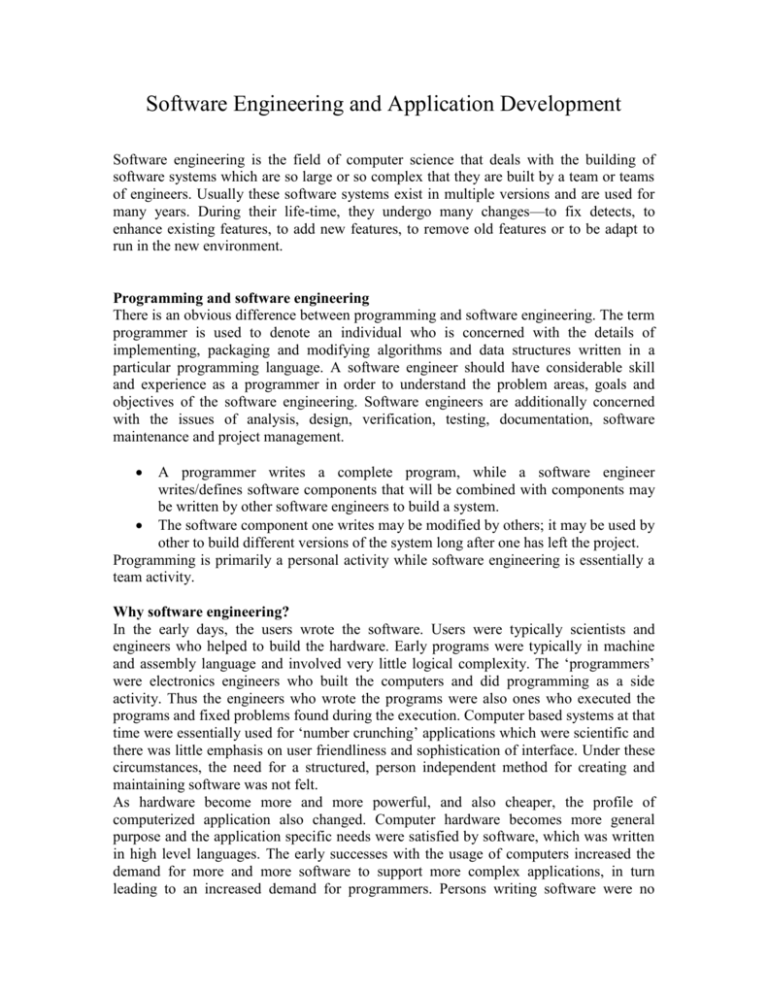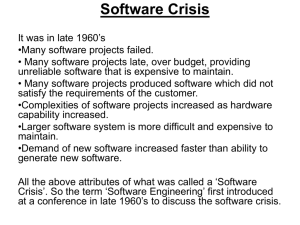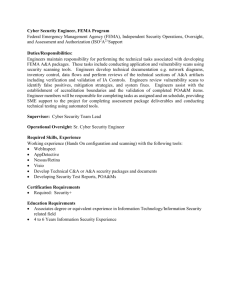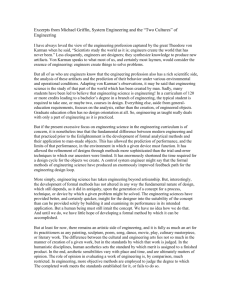Introduction to Software Engineering and Software Product
advertisement

Software Engineering and Application Development Software engineering is the field of computer science that deals with the building of software systems which are so large or so complex that they are built by a team or teams of engineers. Usually these software systems exist in multiple versions and are used for many years. During their life-time, they undergo many changes—to fix detects, to enhance existing features, to add new features, to remove old features or to be adapt to run in the new environment. Programming and software engineering There is an obvious difference between programming and software engineering. The term programmer is used to denote an individual who is concerned with the details of implementing, packaging and modifying algorithms and data structures written in a particular programming language. A software engineer should have considerable skill and experience as a programmer in order to understand the problem areas, goals and objectives of the software engineering. Software engineers are additionally concerned with the issues of analysis, design, verification, testing, documentation, software maintenance and project management. A programmer writes a complete program, while a software engineer writes/defines software components that will be combined with components may be written by other software engineers to build a system. The software component one writes may be modified by others; it may be used by other to build different versions of the system long after one has left the project. Programming is primarily a personal activity while software engineering is essentially a team activity. Why software engineering? In the early days, the users wrote the software. Users were typically scientists and engineers who helped to build the hardware. Early programs were typically in machine and assembly language and involved very little logical complexity. The ‘programmers’ were electronics engineers who built the computers and did programming as a side activity. Thus the engineers who wrote the programs were also ones who executed the programs and fixed problems found during the execution. Computer based systems at that time were essentially used for ‘number crunching’ applications which were scientific and there was little emphasis on user friendliness and sophistication of interface. Under these circumstances, the need for a structured, person independent method for creating and maintaining software was not felt. As hardware become more and more powerful, and also cheaper, the profile of computerized application also changed. Computer hardware becomes more general purpose and the application specific needs were satisfied by software, which was written in high level languages. The early successes with the usage of computers increased the demand for more and more software to support more complex applications, in turn leading to an increased demand for programmers. Persons writing software were no longer computer engineers who knew insides of the computer, nor were they the persons who knew the problem to be solved. It was in late 1960’s Many software projects failed. Many software projects late, over budget, providing unreliable software that is expensive to maintain. Many software projects produced software which did not satisfy the requirements of the software. Complexities of software projects increased as hardware capability increased. Larger software system is more difficult and expensive to maintain. Demand of new software increased faster than ability to generate new software. All the above attributes of what was called a ‘Software Crisis’. So the term ‘Software Engineering’ first introduced at a conference in late 1960’s to discuss the software crisis. Suggestions at the conference that software development might be able to be treated as an engineering problem and it should concern with the theories, methods and tools which are needed to develop software for computers. Once the need for software engineering was identified and software engineering recognized as a discipline, the late 1970’s saw the widespread evolution of software engineering principles. The 1980’s saw the automation of software engineering and growth of CASE (Computer Aided Software Engineering). The 1990’s have seen increased emphasis on the ‘management’ aspects of projects and the use of standard quality and ‘process’ models like ISO 9001 and the Software Engineering Institute’s Software Capability Maturity Model (CMM). These models help organizations put their software development and management processes in place. What is software Engineering? The baseline definition of software engineering was put forward by Fritz Bauer in 1969 as, ‘the establishment and use of sound engineering principles in order to obtain, economically, software that is reliable and works efficiently on real machines’. According to Boehm, software engineering involves, ‘the practical application of scientific knowledge to the design and construction of computer programs and the associated documentation required developing, operating and maintaining them’. IEEE, in its standard 610.12-1990, defines software engineering as: 1. The application of a systematic, disciplined, quantifiable approach to the development, operation and maintenance of software; that is, the application of engineering to software. 2. The study of approaches as in (1). By combining all the above definition we can define software engineering as, ‘Software engineering is the technological and managerial discipline concerned with systematic production and maintenance of software products that are developed and modified on time and within cost estimates.’ Software engineering as a discipline provides us with structured technical means of developing and maintaining software. It provides methods to perform the tasks that the making of any software requires, analyzing the requirements, designing the system to meet these requirements, constructing the programs, maintaining the system, etc. Software engineering tools are used to support the tasks by automating the tasks or parts of the tasks. Goal of software engineering The primary goals of software engineering are: To improve the quality of the software products. To increase the productivity & To give job satisfaction to the software engineers. Foundation of Software engineering / the relationship of software engineering with other disciplines Software engineering is a technological discipline distinct from, but based on the foundation of the following disciplines: Computer Science Management Science Economics System Engineering & Communication Skills Computer Science gives the scientific foundation to the software as electrical engineering relies on physics. Management Science provides the foundation for software project management. Since software engineering is labor intensive activity, it requires both technical and managerial control. Economics provides the foundation for resource estimation and cost control. Since, computing system must be developed and maintained on time and within cost estimates; thus economics plays an important role. System Engineering is the field concerned with studying complex systems. Software is often a component of a much larger system. For example, the software in a factory monitoring system or the flight software on an airplane; is just the component of more complex system. System engineering techniques can be applied to study of such systems Good oral, written and interpersonal communication skills are crucial for the software engineers, because software engineering activities occur within an organizational context, and a high degree of communication is required among customers, managers, software engineers, hardware engineers and other technical workers. . So concepts from computer science, management science, economics, system engineering and communication skills are combined within the framework of engineering problem solving and the result is software engineering. Difference of software engineering with traditional engineering Software is intangible. It has no mass, no volume, no color, no odor--- no physical properties. Source code is merely a static image of computer program, and while the effects produced by a program are often observable, the program itself not. Software design is comparable to architectural design of building in absence of gravity. Excessive degree of freedom is both curse and blessing for software engineering. Software doesn’t degrade with time as hardware does. Software failures are caused by design and implementation error, not by degradation over time. There is always an obscurity in the interface between software modules. A fundamental principle for managing a large system into smaller, more manageable sub units with well defined interfaces. This approach of divide and conquer is routinely used in engineering disciplines. In software engineering the units of decomposition are called modules. Software modules have both control and data interfaces are established by calling relationship among modules and data interfaces are manifested in the parameters passed between modules as well as in the global data items shared among modules. It is difficult to design a software system so that all the control and interfaces among modules are explicit, and so that the modules do not interact to produce unexpected side effects when they invoked one another. In class engineering disciplines, the engineer is equipped with tools and the mathematical maturity to specify the properties of the product separately from those of design. For example, an electrical engineer relies on mathematical equation to verify that a design will not violate power requirements. In software engineering, such mathematical tools are not well developed. The typical software engineering relies much more on experience and judgment rather than mathematical formula. While experience and judgment are necessary, formal analysis are also essential in the practice of engineering. The role of software engineer / The characters of software engineer The evolution of software engineering field has defined the role the software engineer and the experience and education: A software engineer must of course be a good programmer, be well-versed in data structures and algorithms, and be fluent in one or more programming languages. The software engineer must be familiar with several design approaches, be able to translate vague requirements and desires into precise specifications and be able to converse with the use of a system in terms of applications. The software needs the ability to move among several levels of abstraction at different stages of the project, from specific application procedures and requirements, to abstraction for software systems, to a specific design for system and finally to the detailed coding level. The software engineer must be able to build and use a model of the application to guide choices of the many trade-offs that he or she will face. The model is used to answer questions about both the behavior of the system and its performance. The software engineer needs communication skills and interpersonal skills. He also needs the ability to schedule work both of his or own and that of others. So, we see that a software engineer is responsible for many things. In practice many organizations divide the responsibilities among several specialists with different titles. For example, an analyst is responsible for analyzing the performance of a system. A rigid fragmentation of roles is often counterproductive. What is well engineered software? If the software system does what the user wants, and can be made to continue to do what the user wants, it is well engineered. Development of software must include the requirement for the development to be done in a cost effective way, to be constrained by limits on resource and schedule. In addition any software product will be subject to continual change and must be able to be ‘maintained’ in a cost effective way. Any well engineered software system should have the following attributes: be easy to maintain be reliable be efficient provide an appropriate user interface The development of software must make trade-offs between these attributes. Distribution of software effort The typical life-span for a typical software product is 1 to 3 years in development and 5 to 15 years in use. The distribution of effort between development and maintenance has been variously reported depending on the type of software as 40/60, 30/70 and 10/90. Taking the distribution of effort between development and maintenance to 40/60 and normalizing the total effort 100% results in the distribution shown in the following graph: Maintenance: Corrective: Even with the best quality of software, it is likely that customer will uncover defect in software. Corrective maintenance changes the software to correct the defects. Adaptive: Over time, the original environment (CPU, OS, business rules, external product character etc.) for which the software was developed may change. Adaptive maintenance results in modification to the software to accommodate the change to its environment. Perfective: As the software is used, the customer / user will recognize additional function that will provide benefit. Perfective maintenance extends the software beyond its original functional requirements. Again if we think the 40% development separately and taking this as 100%. The division of effort during development is as follows: (i) 40% analysis and design (ii) 20% implementation & (iii) 40% validation The 60% effort of maintenance, taking it as 100%. Then distribution of effort is: (i) 20% adaptive (ii) 60% perfective & (iii) 20% corrective The software product The objective of software engineering is to produce software products. Computer software is the product that software engineers design and built. It encompasses programs that execute within computer of any size and architecture, documents consists of hardcopy and virtual form and data that combine numbers and text but also includes representation of pictorial, video and audio information. In another way we can say, software products are software systems delivered to a customer with the documentation which describes how to install and use the system. Software products fall into two broad classes: (i) Generic products: These are stand alone systems which are produced by a software development organization/firm and sold on the open market to any customer who is able to buy them. (ii) Customized products: These are systems which are commissioned by a particular customer. The software is developed specially for that customer by some developer. Until the 1980’s, the vast majority of software systems which were sold were customized, specially designed systems which run on large computers. They are expensive because all the development cost had to be met by a single client. Since the development of PCs, this situation has completely changed. The PC market is totally dominated by software products produces by companies such as Microsoft. These account for the vast majority of software sales. These are usually relatively cheap because their development cost is spread across hundred or thousands of different customers. However, there is still a large market for specially designed systems. Hardware control always requires some kind of special purpose system. As computers are embedded in more and more devices there is an increasing demand for software controllers, consequently, most software development effort is still probably devoted to producing customized systems. The most significant difference is that the generic software product specifications are produced internally by the marketing department of the product company. They reflect what they think will sell. They are usually flexible and non-prescriptive. By contrast, specifications for customized systems are often the basis for the contract between customer and developer. They are usually defined in detail and changes have to be negotiated and carefully costed. Software product attributes Like all engineering, software engineering is not just about producing product but involves producing products in a cost effective way. Given unlimited resources, the majority of software problems can probably be solved. The challenged for the software engineers is to produce high quality software with a finite amount of resources and to a predicted schedule. The attributes of a software product are the characteristics displayed by the product, once it is installed and put in use. They are not the services provided by the product. Rather, they are concerned with the products dynamic behavior and the use made of the product. Examples of these attributes are therefore, efficiency, reliability, maintainability, robustness, portability and so on. The relative importance of these characteristics obviously varies from system to system. Following are the critical quality attributes of well engineered software: Product Description characteristics Maintainability It should be possible to evolve software to meet the changing needs of the customer. Dependability Software dependability includes a range of characteristics including reliability, security and safety. Dependable software should not cause physical or economic damage in the event of system failure. Efficiency Software should not make wasteful use of system resources such as memory and processor cycle. Usability Software should have an appropriate user interface and documentation Optimizing the above attribute is difficult as some are exclusive. For example, providing a better user interface may reduce system efficiency. The relationship between cost and improvement in each of the attribute is not linear one. Small improvement in any of these attributes may be devoted to optimizing particular attribute.







